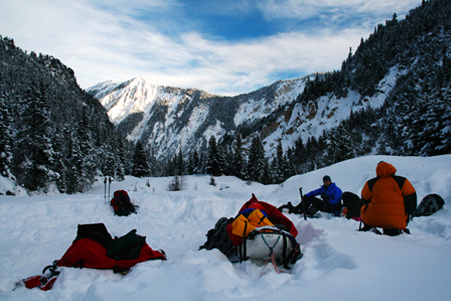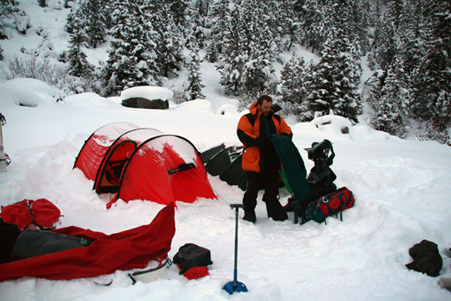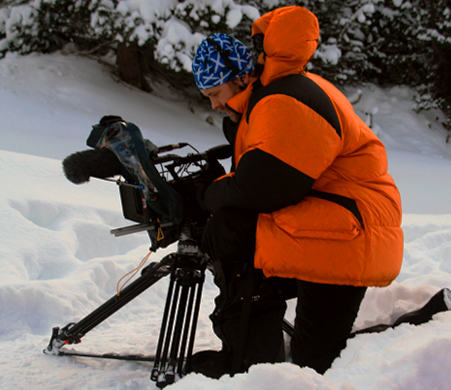A month or two back I was filming a training expedition for two fellas who are undertaking an unsupported trip to the North Pole in 2011. Since one of the main reasons for their trip was to trial and familiarise themselves with some of their kit, I thought I was also the perfect opportunity to put the Canon XF305 to the test.
Now, before I go on to tell you how Canon’s new baby coped, I have to say there are far better written and more technically in-depth posts out there for which I’d advise you have a bit of a search. You can do a lot worse than starting with the likes of Mark Moreve and his short test film, Robin Schmidt’s detailed Sony/Canon comparison as well as The Luminous Landscape’s full review. My post is less of the technical and more of the subjective in relation to the use of the Canon in some of the more demanding environments I visit. Although this post isn’t about how to shoot in damn cold conditions (that may come at some point), do keep in mind that some of the quirks I describe may be unique to this project.
Other than its well publicised ability to shoot BBC-endorsed ‘true’ HD at 50Mbps, my thinking behind taking the XF305 was its size, weight and reported durability in some fairly harsh conditions. Since its Sony cousins had been used at both Poles and most hot and cold places in between (including some rather interesting places in my hands), the challenge of shooting in temperatures as cold as -20C, whilst camping out away from any power/charging source and facing several blizzards, was one to which I was keen to put the Canon.
In terms of kit, in addition to the camera itself, I also went armed with a Genus clip-on matte box complete with French flag, a couple of filters, a top mounted Sennheiser ME66, a pair of reliable radio mics and a lightweight Secced tripod. Spare batteries, cards and the usual goods and shackles were also packed away.

VIVE LA DIFFERENCE
The first thing that was obvious to me, was that the XF305 shoots fantastic pictures. They are clear, crisp and don’t have that innate cool and flat, overly digital feel that I think the Sony EX1/3 can have regardless of the Picture Profile (or Custom Picture in Canon terms) you dial in. The skin tone was excellent both in the standard set up and the BBC TV preset kindly provided by Pro Motion Hire.
The controls are, by and large, where you’d come to expect them on this size of camera and indeed, the similarity with the Sony range was reassuring if you’ve never handled the Canon before. The menus feel familiar enough but do have an understandably slightly alien feel to their layout and wording, as well as to their operation – for example the Canon has a separate ‘set’ button rather than the clickable selection wheel and I found myself trying to depress the select wheel-as you would on a Sony-on more than on occasion.
However, the differences are also to be commended. The ability to fine tune and dial in your own colour temp on ‘preset’ is a lovely feature, as is the power save function, particularly in an environment where the temperature probably reduced the battery life by around 15%. Similarly having a lock function on the audio controls is great, particularly when you have ham-fingers such as mine and a tendency to inadvertently knock buttons and dials.
On that note, I’d have liked the Camera|Off|Media switch to be a tad more robust and not feel like it was off a cheaper domestic camera and, in terms of this shoot, having it positioned on the top of the camera meant it did get filled up up with snow on occasion. Frankly, I ended up taping a hell of a lot of the buttons and switches up and in particular the dreaded Full Auto button was frankly far too easy to knock on. By contrast, switching everything into full manual is a bit of a pain (not just one button, but you also have to adjust lens and other features separately). However, these gripes are rather minor. With real estate on a camera body of this size at a premium, as I mentioned, my cack-handedness may play more than a small part in the threat of pushing unwanted buttons. That said, having no less than 13 assignable buttons does seem slightly excessive!

SUFFERING FROM EXPOSURE
Now, it’s probably worth mentioning at this point that I used very little protection and padding, with exception of a rain-jacket when the weather got seriously hairy, as I wanted to see how far I could push it before there were problems. Indeed, at night the Canon remained in my tent’s porch – covered only by a small tarp and kept well away from the condensation in my sleeping compartment.
With the advances in post-production, I’m not a huge fan of shooting with filters in snow – I much prefer to shoot clean and slightly underexposed and brighten it all up in post. Since negative gain is seemingly a current big deal for many broadcasters (don’t ask me how it works exactly, but you get the idea), and because I was shooting in almost every lighting condition imaginable (bright sun light, hazy snow storms, pitch black) I had the gain set to what I felt was be a more manageable +6, 0, -3, with -3dB used most of the time. However, it’s worth noting that I did over-expose some shots by between a half and two full stops as an experiment to see how the raw footage held up. Delightfully, even at almost 2 stops over the optimum, we could still bring back skin tone and detail without too much issue in post which is astonishingly impressive! However, for those who want it the on-screen exposure meter can be very useful, especially in conditions where judging exposure can be tricky (white snow, black trees, blue haze, subjects in dark colours and so forth).
My constant fear with all small cameras is that the eyepieces are next to useless, usually due to the double whammy of clarity and mounting position. On the first point, the XF305’s eyepiece kicks its Sony cousins’ arses and is remarkably clear considering it’s size and the amount of ‘glass’ between your eye and the picture. However, in cold climates I found it was the first thing to fog up and blur (I’m guessing due to the slight temperature differences between the pockets of air) and this wasn’t easily combatted by moving one’s face away as you would with a full size camera/ eyepiece.
On the second point about position, it may be a mark of me as a cameraman, but frankly the positioning of the eyepiece at the back means I find handholding, particularly at any sort of distance, virtually impossible (especially with a variety of other kit hanging off the camera and a full rucksack etc on my back). Therefore, as predicted, using the screen over the viewfinder wins every time.
The screen is clear, crisp and actually showed some really good colour detail (certainly compared to the Sonys). Now, I still have an issue focusing using LCD based screens/ eyepieces and find some of them rather difficult to perceive quick movement on particularly when shooting progressive, and that fact is compounded in the cold as the crystals begin to solidify. The coldest conditions got before it started showing strobing/trails due to the temperature was about -10C which is quite impressive. There were times that the edge monitor function was useful but it took up valuable screen real estate. However, as I said, the camera was pretty much naked the entire time. A good polar jacket, or even a camera glove with a heat pocket attached to the back of the screen would have solved this problem easily.
There are a few more nice design features I’d like to be mention. I’m rather impressed with the microphone mount. It’s higher than on other cameras this size and sits on a rubber shoe which is brilliant at minimising horrendous transfer of body noise to your external mic you can get on the Sony range. Then again, that could just be my rough fingers again.
Also, the fact the image magnifaction function does not interfere with the recorded picture (as Sony’s expanded image function does) is a nice touch as are the three ‘strengths’ of image stabilisation depending on how ‘long’ and what you are shooting.

RING OF TRUTH
So far, so good. Great pictures, good features and actually really pleasant to operate. However, my major gripe with the XF 305 is the appalling lens. Don’t get me wrong, the optics are really good and the specs are great for its size: 29-520mm. My problem is the movement lag in control rings. I shoot a lot of ob doc style productions and am used to rapid focus, exposure and zoom adjustments. In this respect, the Canon XF305’s lens (which like the EX1 isn’t removable) takes a bit of getting used to. Turn the zoom ring (on manual) and the internal servo speed takes a fraction of a second to think about what you’re doing before actually moving the lens; the result is a weird speed-ramping effect to your action. Crash/ knock zooms are, it appears, out of the question. Now, I will hold my hands up and say I’ve not conducted a proper test on the control latency to see if this effect was compounded by the shooting conditions, but I certainly found it annoying and frustrating at times. Personally, I also found the focus ring to lag slightly as well, however, this may have been a combination of the screen and the temperature.
Weirdly, the iris ring doesn’t feature any markers and can be turned indefinitely which is rather maddening. Sure, you can look at the on-screen display to see what stop you’re at, but the limitless rotation is a seriously weird feature that takes some patience.
Perhaps this markerless approach is due to the fact the XF305 has a rather interesting trick of being able reverse the direction of control for its rings. Slightly strange you would think – and believe me, I do as well. Coupled with the fact the flip out screen is able to come out both to the left and right of the handle, could Canon could be making a play for the (as yet non-existent) ambidextrous market? I have no idea. Besides, I’m right handed. So really I don’t care. Regardless, flip the screen out to the right and it clashes with the microphone mount, so the thinking behind that quirk has got me stumped.
IT’S ALL ABOUT THE ACCESSORIES
A quick work about the Genus mattebox. It’s nice. The 82mm step down ring is a bit of a pain to put on, but them most of these things are. My top tip (particularly in colder temperatures where mental has a nasty habit of contracting) is to use some camera tape on the outside of the step down ring to provide a bit of friction and a fraction more grip between it and the matte box ring. Now, I may have been doing something wrong, but I failed to stop the mattebox from rotating on the step down ring, but this proved rather useful, especially when having to remove the 4×4 filter trays. Despite previously saying I prefer to shoot without filters, a good polariser is extremely useful in snowy conditions. I, however, also succeeded in trashing mine. Regardless, a Formatt ND 0.9 grad was superb in distinguishing the grey/blue/white sky from the grey/blue/white snow…as well as providing some good lens protection when needed.
A QUICK NOTE ABOUT POST PRODUCTION
Data wrangling on the XF305 is a bit of a faff at the moment. Rather than copying the files as you would XDCAM files, I was told to essentially clone the cards onto a harddrive and use the Canon Utility to browse the native XMF files from there. A word of warning to the user though: if you don’t get the file structure exactly correct, you won’t be able to read your files. Once the files are cloned on to the harddrive, we then used Final Cut Pro’s Log and Transfer command to import the files from there. You do have several options for the transfer and what wrappers to use and excellent discussion on which can be found here. In comparison, Avid users will find that there is native XMF codec on their systems although additional plug-ins may be required. However, the workflow is still a tad clunky and should be ironed out in the future. After all, remember how bad the XDCAM workflow was when it first came out?
AND THE VERDICT IS…
Despite some seriously strange functionality quirks and in particular the annoyance of the lens rings, the Canon XF305 is a fantastic camera and produces superb pictures. It handled the comparatively demanding conditions beautifully and I believe produced far nicer images than would have been possible with the Sony EX1. If Canon decided to bring out a more flexible version with a detachable lens, then we’d have a real EX3 beater on our hands and that’s no bad thing. Would I buy one? Well, no. It’s just not flexible enough and the control ring idiosyncrasies are a killer. Will I be using it again? Most certainly.
